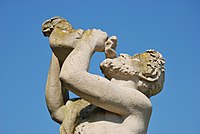
Photo from wikipedia
BACKGROUND AND AIMS Alcohol demand, a measure of alcohol's reinforcing value, is associated with greater alcohol consumption and alcohol-related problems. Although alcohol demand has primarily been evaluated as a "trait-like,"… Click to show full abstract
BACKGROUND AND AIMS Alcohol demand, a measure of alcohol's reinforcing value, is associated with greater alcohol consumption and alcohol-related problems. Although alcohol demand has primarily been evaluated as a "trait-like," individual difference measure, recent evidence indicates that demand exhibits meaningful short-term fluctuations. We aimed to determine whether moment-to-moment fluctuations in alcohol demand in individuals' natural drinking environments predicted drinking occurrence, drinking continuation, and drinking quantity. DESIGN Observational study. SETTING Individuals' natural drinking environments in Columbia, Missouri, USA. PARTICIPANTS 89 young adults (56% female; M age=24.8) participated from November 2018 through October 2020. Participants reported 14.5 drinking days (SD=8.1) and 4.1 drinks per occasion (SD=2.5) during ecological momentary assessment (EMA). MEASUREMENTS Participants completed the Alcohol Purchase Task at baseline. Following, participants reported on their alcohol demand (breakpoint, Omax , intensity) and drinking behavior during EMA at daily, timed prompts from 6:00pm to 2:00am. They provided breathalyzer samples using a BACtrack Mobile® Pro. Models tested concurrent and prospective (lagged) associations between alcohol demand and drinking occurrence and drinking continuation after drinking initiation. Additional models tested concurrent associations between demand and breath alcohol concentrations (BrACs). FINDINGS Higher alcohol demand was associated with higher odds of drinking and continued drinking for all demand indices at the momentary (odds ratios [ORs]=1.27-1.56, ps≤.03) and day-level (ORs=2.14-3.39, ps<.001). Additionally, lagged demand predicted higher odds of drinking occurrence and continuation at the following prompt (ORs=1.32-1.53, ps≤.004). Higher alcohol demand was associated with higher BrACs at the momentary (bs=0.0011-0.0026, ps≤.03) and day-level (bs=0.0053-0.0062, ps<.001). At the person-level, findings varied depending on the demand measure. CONCLUSIONS Alcohol demand appears to be associated with both when and how much individuals drink in their natural drinking environments. Elevations in alcohol demand appear to be associated with increased likelihood of drinking and continuing to drink, and greater total alcohol consumption, both within and across drinking days.
Journal Title: Addiction
Year Published: 2022
Link to full text (if available)
Share on Social Media: Sign Up to like & get
recommendations!